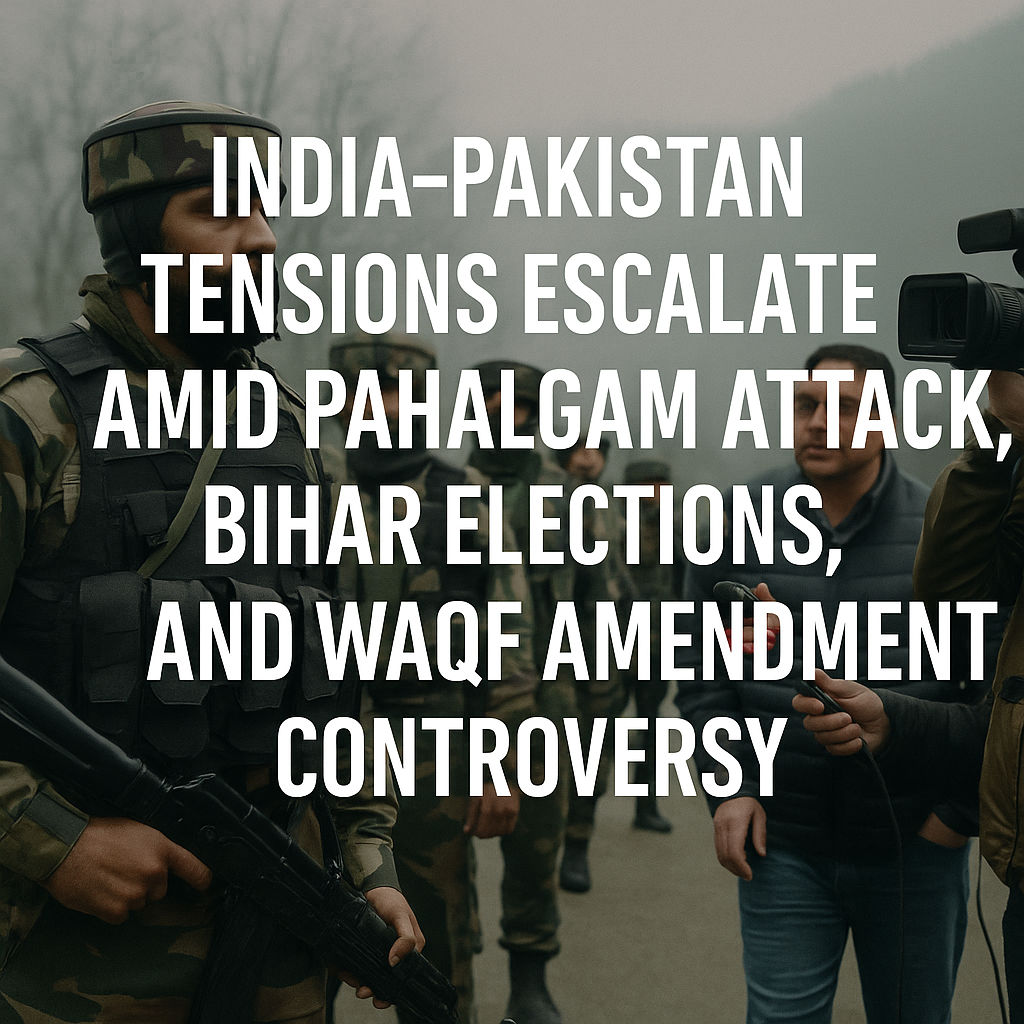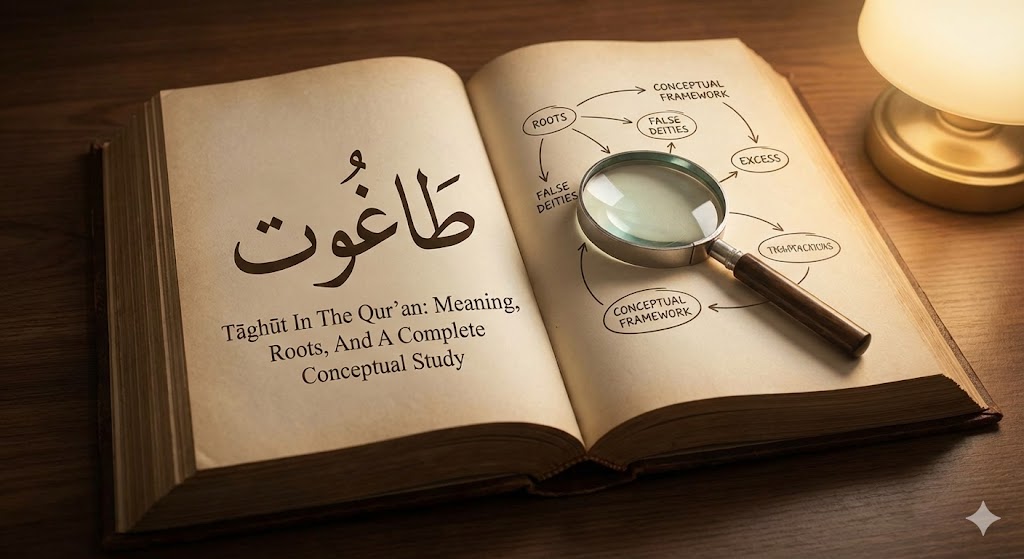The South Asian region, already a hotspot for geopolitical volatility, has once again been thrust into the global spotlight following a dramatic escalation in tensions between India and Pakistan. The spark for this latest confrontation was a brutal and coordinated terrorist attack in the tourist destination of Pahalgam in Indian-administered Kashmir, which left 26 civilians dead, including two foreign nationals. Claimed by The Resistance Front (TRF)—a group widely believed to be backed by Pakistan-based Lashkar-e-Taiba—this attack not only shook the fragile peace in Kashmir but also triggered a chain reaction with far-reaching political, religious, and diplomatic consequences.
At the same time, India is heading into one of its most politically charged regional elections in Bihar—home to over 17% Muslim population, a community that has been vocally resisting recent legislative changes targeting Islamic institutions. Chief among these is the highly controversial Waqf (Amendment) Act, 2025, which aims to overhaul the administration of Muslim religious endowments, stripping away many of the traditional protections and representative structures that governed them. Critics see this move as part of the Bharatiya Janata Party (BJP)’s broader agenda to consolidate Hindu nationalist sentiment and marginalize Muslim voices, especially during an election cycle.
This convergence of military escalation, internal communal unrest, and political maneuvering has sparked a whirlwind of speculation both within India and internationally. Is this latest flare-up with Pakistan a genuine security threat or an orchestrated move to rally nationalistic support before crucial state elections? Could the BJP be using the incident to divert attention from domestic controversies like the Waqf Amendment and Muslim protests? And more alarmingly, is there a third force—foreign or domestic—deliberately fueling the fire for its own strategic gain?
In this comprehensive analysis, we explore all possible angles of this volatile situation: the military dimensions, the political calculus behind BJP’s strategy, the impact on Indian Muslims, the role of the Bihar election, the plausibility of cross-border infiltration, and the deeper question of who truly benefits from keeping the India-Pakistan border in a state of perpetual conflict. We draw upon insights from Indian, Pakistani, and international media, as well as geopolitical analysts and security experts, to present a full picture of what may be one of the most consequential standoffs in recent South Asian history.
Pahalgam Attack and Its Aftermath
On the morning of April 22, 2025, what was supposed to be a peaceful day for tourists in the serene meadows of Baisaran, near Pahalgam in Jammu and Kashmir, turned into a bloodbath. A group of armed militants ambushed a cluster of tourist vans and local guides, opening fire indiscriminately. By the time security forces arrived, 26 civilians—including two foreign tourists from Southeast Asia—had been killed, and over a dozen others injured. Eyewitness accounts confirmed that the attackers selectively targeted non-Muslim tourists, pointing to a chilling pattern of sectarian motivation.
Within hours, the attack was claimed by The Resistance Front (TRF), a relatively new but deadly offshoot of the Lashkar-e-Taiba (LeT), a Pakistani-based group designated as a terrorist organization by the United Nations. Indian intelligence agencies stated that they had intercepted chatter from handlers based in Pakistan-occupied Kashmir (PoK), further fueling suspicions of cross-border orchestration. Pakistan’s Foreign Ministry, however, swiftly denied any involvement, condemning the attack and calling for an independent investigation—claims that New Delhi firmly rejected.
India’s Diplomatic and Military Response
The Indian government’s response was swift and aggressive. Prime Minister Narendra Modi convened a high-level security meeting the same day and announced a series of retaliatory measures:
- Diplomatic Expulsions: Two Pakistani High Commission officials were declared persona non grata and given 48 hours to leave India.
- Suspension of Visas: All tourist, business, and even emergency medical visas for Pakistani nationals were immediately suspended.
- Indus Waters Treaty Review: India announced a temporary withdrawal from the historic Indus Waters Treaty, signaling a willingness to reassert control over river flows as a pressure tactic.
- Increased Troop Deployment: Additional Indian Army battalions and CRPF contingents were sent to reinforce the Line of Control (LoC) and sensitive areas in Jammu and Kashmir.
- Surveillance and Air Strikes: Unconfirmed reports from Indian media suggest that retaliatory airstrikes targeted suspected TRF camps in PoK, although Pakistan’s military dismissed the claims as “fabricated propaganda.”
Pakistan’s Countermeasures
Pakistan, on the other hand, responded with equal fervor:
- Suspension of the Shimla Agreement: In a symbolic move, Islamabad suspended its commitment to the 1972 Shimla Agreement, which governed peace protocols and diplomatic conduct between the two nations.
- Closure of Airspace and Trade Routes: Pakistan shut down airspace for Indian aircraft and halted cross-border trade through the Wagah and Munabao routes.
- Military Drills: Pakistan’s military began conducting live-fire exercises near the border, presenting it as a precautionary move to defend sovereignty.
The sudden spiral in relations evoked fears of another full-scale military standoff similar to the Balakot episode in 2019, when Indian fighter jets crossed into Pakistani territory following a suicide bombing in Pulwama.
Intelligence and the Infiltration Debate
What makes the Pahalgam attack particularly alarming is the geography. Baisaran is not located directly adjacent to the LoC; it’s about 40–50 km deep into Indian territory. This raises a critical question: Is it realistically possible for infiltrators to travel from the LoC to Pahalgam without being detected by the Indian Army, which maintains one of the most extensive surveillance networks in the world?
Some analysts believe this could point to local sleeper cells or domestically radicalized elements receiving remote instructions. Others speculate that high-altitude routes—unused in winter months—might have been reactivated under cover of changing weather.
The possibility of assistance from insider networks, or collusion by disenchanted locals, is also under investigation. It adds a layer of complexity, suggesting that even the most fortified surveillance grid is vulnerable to ideological subversion.
Bihar Elections and Political Implications: War Rhetoric as a Political Strategy
The timing of the Pahalgam attack and subsequent escalation with Pakistan is far from coincidental when examined through the lens of India’s internal politics—particularly the ongoing Bihar state assembly elections. Bihar is not just any electoral battleground; it is one of the most politically sensitive and demographically complex states in India, with a significant Muslim population (around 17%) and a long-standing tradition of caste and community-based voting behavior.
The ruling Bharatiya Janata Party (BJP), led by Prime Minister Narendra Modi and Home Minister Amit Shah, has historically relied on nationalistic fervor, muscular foreign policy posturing, and Hindu-majoritarian narratives to galvanize its electoral base. The 2019 Lok Sabha elections saw the BJP sweep to power shortly after the Pulwama attack and the Balakot airstrikes—both of which framed the BJP as India’s sole “protector” against terrorism and cross-border threats.
Now, in 2025, with growing dissatisfaction among youth due to unemployment, rising inflation, and controversial policy reforms affecting religious minorities, the BJP faces mounting challenges in Bihar. According to internal polls leaked to Indian media outlets, the BJP-JD(U) alliance was forecasted to lose over 50 seats, many in Muslim-majority constituencies. The party needed a new narrative to shift the political momentum—and the Kashmir-Pakistan front provided one.
Weaponizing National Security for Electoral Gain
Immediately after the Pahalgam incident, BJP leaders began delivering fiery speeches across Bihar, linking national security to voting choices. Prime Minister Modi, while addressing a rally in Patna, stated:
“The enemies of Bharat do not just sit across the border—they walk among us. And only a strong government can weed them out.”
The subtext was clear: vote for BJP to defeat Pakistan-backed terrorism and secure the nation. BJP’s media cells released video montages juxtaposing images of the attack with slogans like “Desh ke gaddaron ko, goli maaro saalon ko” (Shoot the traitors of the nation)—a disturbing echo of past hate-filled campaigns.
State and national TV channels, many of which lean heavily towards BJP’s narratives, devoted endless hours to dissecting the “Pakistan threat” while downplaying or outright ignoring growing unrest among Muslim voters, the implications of the new Waqf legislation, or the government’s economic shortcomings.
This diversion strategy is a hallmark of “rally-round-the-flag” politics, where external threats are used to suppress internal dissent and manufacture consent around strongman leadership. The parallels with previous electoral cycles are stark—and deliberate.
Targeting Muslim Voters and Silencing Dissent
Muslims in Bihar have been increasingly vocal against BJP’s policies in recent years, especially after the passage of the Citizenship Amendment Act (CAA) and the proposed National Register of Citizens (NRC), both of which were perceived as discriminatory.
In April 2025, the Indian Parliament passed the controversial Waqf Properties (Regulation and Reform) Amendment Bill, which transferred administrative rights of several Muslim charitable institutions (auqaf) to state-appointed bureaucrats, stripping elected Waqf boards of their control. Critics, including prominent Muslim leaders, activists, and scholars, have termed this as a “soft seizure” of Islamic endowments, aimed at weakening the socio-economic base of India’s Muslim population.
Massive protests erupted in cities like Patna, Muzaffarpur, and Gaya—many led by youth groups and religious scholars. The BJP-led central government responded by detaining several protest leaders under preventive detention laws and branding the movement as “radicalization under foreign influence.”
Analysts argue that the war narrative around the Pahalgam attack is being used not just for electoral gains but also to delegitimize and suppress these protests. By conflating domestic dissent with terrorism and Pakistani interference, the government effectively criminalizes opposition from India’s Muslim community.
This environment of fear and suspicion is meant to intimidate Muslim voters, many of whom are reportedly considering boycotting the elections or shifting allegiance to regional parties like the Rashtriya Janata Dal (RJD) and the All India Majlis-e-Ittehad-ul-Muslimeen (AIMIM).
Opposition’s Struggle to Counter the Narrative
While the BJP has mastered the art of converting national crises into electoral victories, the Indian opposition continues to falter. The Congress, RJD, CPI(ML), and other Bihar-based parties condemned the attack but struggled to formulate a coherent counter-narrative that both denounced terrorism and questioned the timing and handling of the incident.
Tejashwi Yadav, RJD leader and former Deputy CM of Bihar, accused the BJP of “manufacturing outrage for political gain” and raised concerns about intelligence failures. However, these statements were quickly drowned out by BJP’s dominant media machinery and labeled as “anti-national” rhetoric.
Moreover, the opposition’s hesitation to directly confront the national security narrative—fearful of being branded “soft on terrorism”—has allowed the BJP to frame the entire discourse on its terms.
Impact on India’s Muslims and the Waqf Law: Silent Seizure or Reform?
Amidst the national uproar over the Pahalgam attack and the war-like atmosphere along the Line of Control, a quiet but momentous development took place in the Indian Parliament: the passing of the Waqf Properties (Regulation and Reform) Amendment Bill, 2025. While it received little attention in mainstream media due to the ongoing Indo-Pak tensions, the bill has sparked deep unease within India’s Muslim community—both for its substance and timing.
What Is the Waqf Amendment Bill?
The Waqf (or Auqaf) system is a centuries-old Islamic charitable endowment framework under which property, land, or money is donated for religious, educational, or philanthropic purposes. In India, Waqf boards are autonomous bodies created under the Central Waqf Act of 1995 to manage these assets—many of which include mosques, graveyards, schools, orphanages, and community centers.
The 2025 amendment bill, passed hastily with limited debate, makes several controversial changes:
- Transfer of Administrative Powers: The bill authorizes state governments to appoint their own administrators to oversee Waqf properties, significantly reducing the autonomy of elected Waqf boards.
- Audit and Surveillance Powers: It empowers government agencies to conduct audits, freeze assets, and seize records of Waqf bodies without prior notice.
- No Judicial Review: The bill limits the scope for affected parties to challenge Waqf-related decisions in civil courts, centralizing grievance redressal in government-appointed tribunals.
- Land Reclassification Provisions: Several clauses in the bill allow state governments to reclassify or repurpose Waqf lands deemed “underutilized” for “public interest,” a vague and legally ambiguous term.
These provisions have led to growing fears that the bill could be used to systematically dismantle Waqf institutions and strip Muslim communities of their collective assets under the pretext of “modernization” or “urban development.”
A Pattern of Legislative Targeting?
The passage of this bill is being viewed in a broader context of recent legislative moves that have disproportionately affected India’s Muslims:
- The Citizenship Amendment Act (CAA) introduced religious criteria for naturalization.
- Triple Talaq Criminalization Bill penalized a Muslim personal law practice, drawing criticism for selectively criminalizing one community.
- The Bulldozer Policy, employed in BJP-ruled states like Uttar Pradesh and Madhya Pradesh, led to the demolition of Muslim-owned homes and shops during communal clashes without proper legal procedure.
- Selective Surveillance through the Pegasus spyware scandal revealed that several Muslim journalists, activists, and scholars were being monitored.
Together, these moves point to a consistent ideological trajectory where India’s ruling party appears to be shrinking the civil, legal, and economic space for Muslims under the broader narrative of “national interest” or “reform.”
Muslim Community’s Reaction: Mistrust and Mobilization
Following the Waqf amendment bill’s passage, Muslim organizations, religious scholars, and civil society groups held emergency consultations across several Indian cities. Prominent Muslim bodies like:
- All India Muslim Personal Law Board (AIMPLB)
- Jamaat-e-Islami Hind
- Jamiat Ulama-e-Hind
have condemned the bill as “an unconstitutional overreach” and a “direct assault on the religious freedom guaranteed under Article 26 of the Indian Constitution.” In Bihar, where Muslims form a key electoral bloc, protests have erupted across Patna, Gaya, and Bhagalpur. In some districts, local mosques issued open appeals urging community members to remain united and not be provoked by political tactics disguised as security concerns.
However, given the war-like narrative being pushed nationally, these protests have been underreported, mischaracterized, or even criminalized. Some protest leaders have already been detained under preventive detention laws, and state police have invoked the Unlawful Activities Prevention Act (UAPA) against a few activists.
Media Narrative: Erasure and Distortion
A critical element in this unfolding drama is how Indian media—particularly the pro-government channels—have covered or ignored the Waqf bill. The few segments that did cover the story portrayed the move as a “bold reform to clean up Waqf corruption,” without acknowledging the constitutional, religious, or socio-political sensitivities involved.
Independent media outlets such as The Wire, Scroll, and Caravan Magazine have run stories warning that the bill paves the way for land grabs in Muslim-dominated urban centers, particularly in Delhi, Hyderabad, and Lucknow. But their reach remains limited compared to national TV broadcasters, who continue to focus on Pakistan, Kashmir, and “anti-national elements.”
This selective silence, critics argue, is designed to prevent the larger Indian electorate—especially in poll-bound Bihar—from sympathizing with Muslim grievances or understanding the erosion of minority rights under the guise of national security.
The Chilling Effect on Muslim Political Participation
The chilling effect of this bill—combined with the broader anti-Muslim rhetoric associated with war escalation—is already visible:
- Muslim voters are reporting intimidation at the hands of local police and administration when attempting to organize political meetings or protest gatherings.
- Minority candidates from opposition parties are facing legal scrutiny or character assassinations.
- Religious leaders are being pressured into silence, with some mosques receiving anonymous warnings not to “politicize the pulpit.”
The BJP’s strategy seems clear: marginalize Muslim political voices, push voters into silence, and then claim that there is no opposition from the Muslim community to government reforms.
Security Concerns and Cross-Border Infiltration
The Pahalgam attack has raised questions about security lapses and the possibility of cross-border infiltration. Given the proximity of Pahalgam to the Line of Control (LoC), concerns have been voiced about the ability of militants to traverse the heavily monitored border undetected. While the Indian Army maintains a robust presence along the LoC, the rugged terrain and complex geopolitical dynamics pose ongoing challenges to border security.
Potential Third-Party Involvement
The question that now dominates public discourse is: Who truly benefits from this attack? While both India and Pakistan stand to lose from further destabilization, the timing raises suspicions. Multiple intelligence sources and global analysts have pointed to a “third force”—perhaps state-sponsored actors or international players—who may wish to:
- Reignite Indo-Pak conflict to derail regional cooperation efforts.
- Distract Pakistan from growing political instability and economic default.
- Provide political mileage to India’s ruling party amid electoral setbacks and internal dissent.
Although concrete evidence is lacking, this theory cannot be completely dismissed, particularly in the modern landscape of cyber-warfare, proxy militancy, and psychological operations.
Conclusion
The confluence of the Pahalgam attack, political maneuvering ahead of the Bihar elections, and the contentious Waqf (Amendment) Act underscores the intricate interplay between security, politics, and communal relations in South Asia. As India and Pakistan navigate this complex landscape, the imperative for measured responses, inclusive governance, and sustained dialogue becomes ever more critical to ensure regional stability and harmony.
Note: This article is based on information available as of May 3, 2025. Developments may have occurred since this date.










